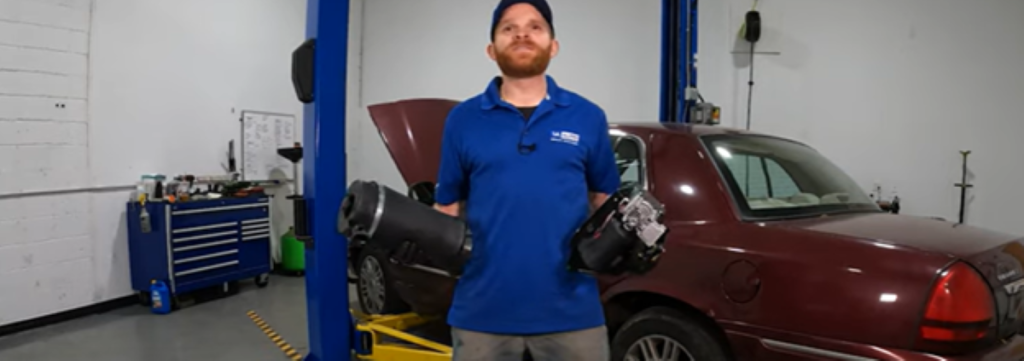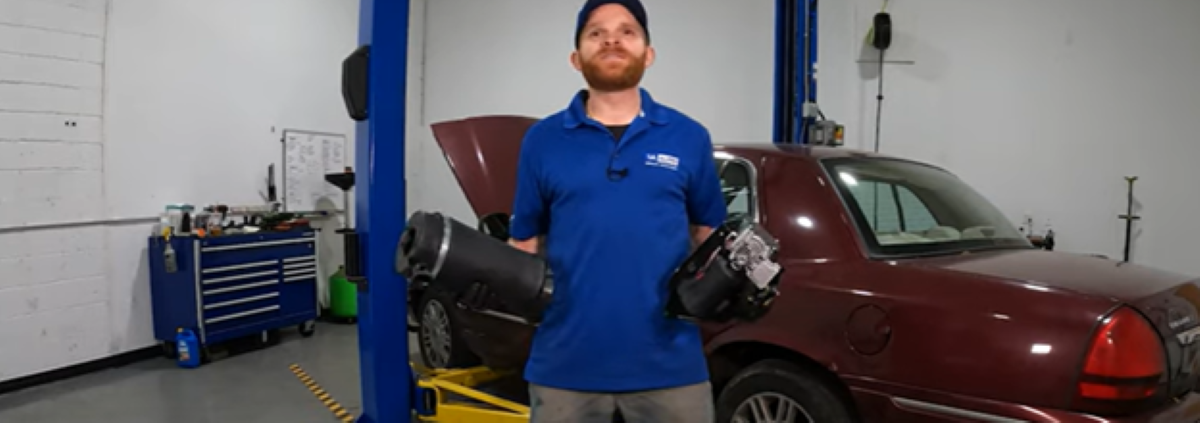If you own a vehicle with an air suspension and your drive isn’t as comfortable or as smooth, follow these tips from our expert mechanics. Find out the symptoms of a bad air suspension and how to diagnose your own air suspension parts.
How to Diagnose Air Suspension Parts

Symptoms of Bad Air Suspension Parts
Symptoms of bad air suspension parts can range from the car feeling different and bumpier while driving to a check air suspension light turning on.
Less Ride Comfort
If your vehicle has an air suspension and it feels like your car is unstable, low in the back, and like you can feel every bump, it may be time to fix the suspension.
Swaying and Poor Handling
If the air suspension is causing your car to ride too low, the vehicle can sway and you may notice your car has poorer handling. This problem makes driving your car dangerous and it can damage to the suspension.
Lower Suspension
The suspension may be lower or feel lower if there’s a problem with a part like the compressor not working. This is dangerous and can damage other parts in the system.
Air Pump Problems
If the pump does not make noise, that’s a symptom of it not working. If it turns on and off intermittently, that’s a sign of a leak in the air suspension system.
Damaged Parts

Air lines can brittle and break down over time, leading to leaks. The air bags can also crack and cause leaks.
Check Air Suspension Light

A light may turn on on the dash for your vehicle’s air suspension, like, “stop, car riding low.” From here you can check for fault codes with a scan tool, which might lead to a suspension code.
Parts of the Air Suspension System

Generally, an air suspension system has three components:
- Air compressor
- Air bags
- Height control valves
Why Are My Air Suspension Parts Failing?
Air shocks are designed to function under a certain amount of air pressure. If there’s too much pressure, your ride will feel less comfortable than usual.
Steps to Diagnose Air Suspension Parts Yourself
General steps to diagnose an air suspension system
- Visually Inspect Your Vehicle for Sagging
Check your vehicle for sagging to the side or from the front to the rear.

- Locate the Air Suspension System
Air suspension systems can be located at the rear, and sometimes at the front and rear depending on the vehicle.
- Listen for the Air Pump to Work
If the air pump isn’t making noise, that’s a sign it’s not working, and that’s usually due to an electrical issue, like a fuse, level sensor, or the compressor.
More on How to Diagnose and Fix a Bad Air Suspension Kit in GM Vehicles
An intermittent air compressor pumping on and off is a sign of an air suspension leak and could burn out the compressor. - Inspect the Compressor Unit
The compressor unit should have valves and a pressure sensor. Check these connections for corrosion or melting, which can cause an electrical issue.

- Check the Manual Switch for the Air Suspension
Many vehicles have a manual switch in the trunk for the air suspension. If the shocks have been receiving too much air, you can turn the air suspension off to take weight off the suspension or air bags while the key is in the ON position at the same time.
Also, if the vehicle was lifted off the ground for maintenance, the switch may have been turned off and left off, which is dangerous and can damage these parts.
- Spray the Valves, Connectors, Air Bags, and Air Lines with Soapy Water
Spray soapy water onto the air lines, valves, connectors, and air bags. You may find air lines that are dry and brittle, and they could eventually break. Dry-rotted and cracked air bags are also a sign of a leak. Areas where air is leaking will bubble.

- Listen for Air Leaks
Sometimes air leaks can make noise. Listen for any whirring or a sound of air escaping.
- Diagnose for Air Leaks with a Scan Tool
You can also diagnose for leaks with an advanced scan tool that’s capable of monitoring this kind of suspension to check for codes and monitor the sensor’s performance.
More on how to diagnose air suspension parts with a scan tool
How to Fix Common Problems with the Air Suspension
Convert to Coil-Over Shocks

Fixing air suspension parts can be more costly and complex than a vehicle with coil-over suspension, so you might find you want to convert. The process could be as easy as removing a fuse to prevent power from reaching the compressor, and then removing the air bag suspension and shocks and installing new coil-over shocks.
It’s important to note that the vehicle won’t feel the same with a new coil-over suspension. Also, some vehicles have computerized air suspension systems that can adjust the pressures independently and changing the suspension system can cause issues with the vehicle’s stability and traction control system.
Fix and Replace the Car Air Suspension Parts Yourself
If you find a leak, you can replace the broken component without having to replace every part in the system. You can also replace damaged air suspension parts yourself. It’s important to note the system could still have pressure in it, so we recommend being very careful and wearing hand and eye protection.
How-to Videos to Fix Your Vehicle
Check out our how-to video library and learn how to fix air suspension parts yourself and more with step-by-step instructions and tips from our expert mechanics.
Shop Quality Air Suspension Parts, Conversion Kits, and More


